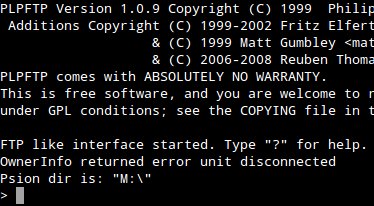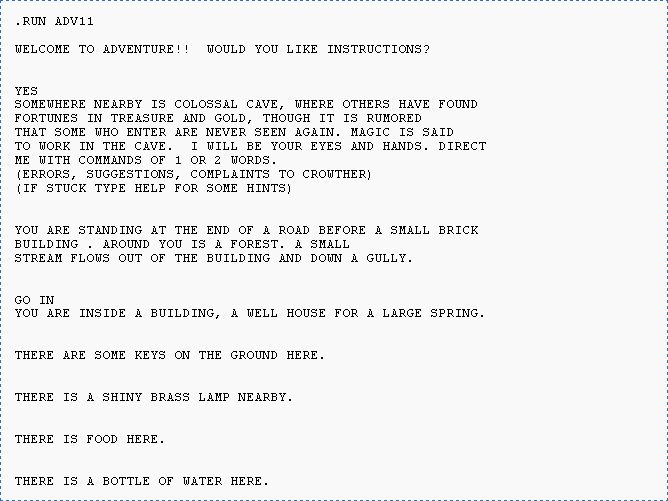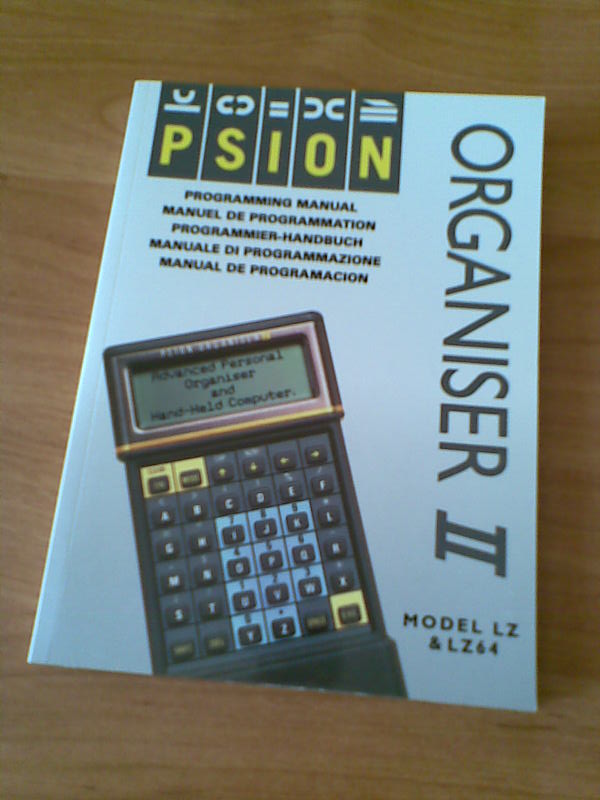Hinges 2: Psion

This time about healing broken hinges in SIBO Psions. It seems that this happens to be an issue in Psions too.
David MacKay has written an exhaustive and excellently illustrated tutorial on how to repair the hinges. You may find it on his website, where several other useful tips can be found.
Edited 2019/03/23:
It's not always a spring that breaks, sometimes (due to continuous strain?) you get a crack on one of the sides of the button bar - and it's a good news as it's much easier to fix. You can read a brief repair guide here.
(Note: instead of a piece of ABS as the author suggests, I used a paper staple bent to make a square frame - I'm not sure if it's better, but it seems to be doing its job.)
[RC] Learning resources

The best book on programming (SIBO and EPOC) Psion machines is "Programming Psion Computers" by Leigh Edwards. It covers wide range of topics, including SIBO architecture, available programming tools and detailed OPL reference. And it's free 🙂
You can download it from Gareth Saunders' website, as well as the OPL reference in various formats (including Psion's database file).
For learning OPL you can also take a look at the tutorials devoted to programming Symbian machines (this one, for instance).
[RC] Retrochallenge!

The 2013 Summer Competition has started and so have I - for the first time. For long I thought I would do something on Atari Portfolio, but at the end of June, when my Portfolio went dead (batteries) once again, I changed my mind.
My Psion Series 3c has never disappointed me; besides, I love the design of SIBO - its operating system. Moreover, the whole Series 3 family is more or less compatible (the original Series 3 and Workabout a little less, but they all share the same system), so writing a program for one model can benefit them all - just look at Barbarians by Damian Walker. I decided to port robotfindskitten to the Series 3 family - just for fun and to get familiar with programming the Psions. Maybe something else will be born after this month, who knows...
I'm waiting for the feedback from all Psioneers! Hearing from you that you still play with your Psions will greatly encourage me to do more.
Psion, Linux PC and a cable

I remember that I promised to write something about connecting Psion palmtop (either Series 3 or Series 5) to a Linux-based PC without using CF card. Just a PC-Link cable.
The great news is that many Linux distributions... already have everything we need. Yes. If you own Ubuntu or other debianoid, simply install plptools (sudo apt-get install plptools). The same for RedHat; I don't know about other distros.
Now the bad part. Since Ubuntu 11.04 (?) the "core" feature of plptools, called plpfuse, has been disabled. I read that it was because there had been some problems with it. Generally, it was a daemon mounting Psion's filesystems as a normal drive. I tried it in Ubuntu 10.04, but it really didn't work well, so no. We'll do it the other way.
There are two programs included in plptools (not only, but we'll focus on these): ncpd and plpftp. The former is a daemon that establishes connection between Psion and the PC, and the latter... as the name says 🙂
That's how I do it:
1. I connect the Psion with the PC using PC-Link cable.
2. From Psion's main menu I choose Special > Communications and set it to "Link cable" at 57600 baud. (Or whatever the maximum is; for Siena it would be 19200.)
3. I open a terminal window and type:
sudo ncpd -s/dev/ttyUSB0 -b57600 -d
for I have the cable plugged in to the USB port using an adaptor. In case the above code doesn't work, execute dmesg | tail and try to find out what the name of the device should be. Also remember to check the baud rate entered (the -b parameter).
If everything went alright, the daemon should start running without any message.
4. I open a second terminal window, change the directory to where my files for exchange are and launch plpftp:
plpftp
Plpftp complains about an error from OwnerInfo, but that doesn't matter. Commands are similar to those in every command line-driven ftp client:
cd DIR - changes the directory on Psion's drive
dir - lists the contents of the current directory (Psion)
lcd DIR - changes the directory on the PC
mkdir DIR - creates a directory on Psion's drive, in the current location
put FILE - sends a file to Psion
get FILE - you guess it
mput, mget - allow to use wildcards (*) in file names
Notice: file names on Psion's drives are case-insensitive. On the PC they are not.
And that's basically all you need to send and receive files between Psion and a PC. For more commands type help while in plpftp.
5. After a successful session I quit plpftp (bye) and shut down ncpd using Ctrl-C.
Happy vintage computing in the new year! 🙂
[Edit 2013/02/06]:
mii3 sent a useful shell script to synchronize the Psion. I guess it's taken from this forum post, where you can also find the required usbpsion script.
#!/bin/sh
# Requires:
# plptools_0.18-1_i386.deb
# for i386
if [ "$( dpkg -l | grep plptools )" = "" ] ; then
echo “Requires plptools”
exit
fi
if [ "$1" = "--help" ] ; then
echo “If you would like to sync from/to psion”
echo “irdabelkin to get the irattach”
echo “then you do ircp-tray with x11″
echo
echo “If you wanna with cable /dev/ttyUSB0 you shall do use this program with –sync”
echo “Place your file in the right directory, check –init”
exit
fi
if [ "$1" = "--rox" ] ; then
rox ~/Documents/mydevices/psion/pc2psion/
exit
fi
if [ "$1" = "--init" ] ; then
echo “Creating dirs”
mkdir -p ~/Documents/mydevices/psion/pc2psion/
exit
fi
if [ "$1" = "--sync" ] || [ "$1" = "" ] ; then
# check if usb serial is present
CHECKIFUSB0=` ls -1 /dev/ttyUSB0 `
if [ "$CHECKIFUSB0" = "" ] ; then
echo “** Warning: no USB cable for the psion detected. **”
exit
fi
CHECKSUDOUS=` sudo -l | grep usbpsion `
if [ "$CHECKSUDOUS" != "" ] ; then
# prepare
WOHOME=` whoami `
echo “** mount”
sudo usbpsion –mount $WOHOME
# Check mount
FILELISTC=` ls -1 /media/psion | grep “C” `
if [ "$FILELISTC" = "" ] ; then
echo “** Not Mounted **”
exit
else
echo “** Mounted **”
fi
echo “** LIST **”
ls /media/psion
echo
# check few dirs
[ ! -d ~/Documents/mydevices/psion/pc2psion/ ] && mkdir -p ~/Documents/mydevices/psion/pc2psion
ls ~/Documents/mydevices/psion
# operation of sync if possible
CHECKIFMOUNT=`ls ‘/media/psion/C:’ | grep System`
if [ "$CHECKIFMOUNT" != "" ] ; then
echo ” > Status: mounted”
echo “** Sync”
# ******* PC => PSION
echo
printf “33[32m%10s\n33[0m" "PC => Psion"
cd ~/Documents/mydevices/psion/
cp -av pc2psion/ '/media/psion/C:'
rm ~/Documents/mydevices/psion/pc2psion/*
# ******* PSION => PC
echo
printf "33[32m%10s\n33[0m" "Psion => PC"
[ ! -d '/media/psion/C:/psion2pc/emails/' ] && mkdir -p ‘/media/psion/C:/psion2pc/emails/’
ls ‘/media/psion/C:/psion2pc/’
cp -r -v ‘/media/psion/C:/psion2pc/’ ~/Documents/mydevices/psion/
# ******* BACKUP
echo
printf “33[32m%10s\n33[0m" "Backup: Psion => Psion (D:)"
[ ! -d '/media/psion/D:/backup/psion2pc/' ] && mkdir -p ‘/media/psion/D:/backup/psion2pc/’
ls ‘/media/psion/C:/psion2pc/’
cp -r -v ‘/media/psion/C:/psion2pc/’ ‘/media/psion/D:/backup/psion2pc/’
fi
echo “** Umount”
sudo usbpsion –umount
exit
fi
fi
Games: A for Adventure

One of the fields where vintage palmtops can easily compete with modern gadgets, is adventure gaming. I mean those games where you type "examine box" and the computer tells you that there is a small piece of paper inside. Or something else. A lot of games were written for portable computers in the heyday of adventure gaming (80's and the beginning of 90's).
If you don't know, what these "adventures" are about, read the excellent introduction by Joe W Aultman or an exhausting beginner's guide at Brass Lantern.
Psion Organiser
Yes, there are adventures for the Organiser. You may download a port of Colossal Cave Adventure and an original game "City of Alzan" from The Psion Organiser II site. They should run on an CM! (haven't tested though)
Psion Series (SIBO)
With these machines you can access all Infocom titles (.IDF format) thanks to the ITF Interpreter by Bryan Scattergood. You can download it as well as Zork I from BioEddie's.
Psion Series (EPOC)
For Psion 5 (and higher) there is FrotzS5 Z-Code interpreter. This lets you play hundreds of games stored on Interactive Fiction Archive website and elsewhere on the Internet. You may also want to take a look at this page, where you can find a brief installation info together with an entire Zork trilogy for download. (Here's an archived instruction manual for FrotzS5.)
Amstrad NC
There are a few amusing adventure games available from Tim's Amstrad NC Users' Site, like "Crystal of Nebumeth". NC's full-sized keyboard and large screen make it really comfortable to play adventures even for a long time. Amstrad has a BBC BASIC interpreter built in, so new games may be easily written (the source codes of existing games may help you get started).
Atari Portfolio
You can download a few games from atari-portfolio.co.uk. I don't think that any DOS Z-code interpreter would run on a Portfolio, but I didn't even try. Maybe there is a lightweight version, capable of running on a very basic XT?
EDIT: There is an interpreter with a few games (including Zork Trilogy). You can download it from PofoWiki's download section (infocom.zip).
HP LX
There are some titles on the S.U.P.E.R. site. You need to be patient, though, and click through those hundreds of programs listed (no categories). DZip (16-bit DOS version) should run on every LX (most likely on 200LX).
Palm
There are a few Z-code interpreters for Palms, like Pilot Frotz or Pilot Zip, but I've used only one of them - Frobnitz. It supports all Z-code file formats (except V6) and is quite powerful, but larger games are slow like hell on my IIIe.
Useful links:
- Interactive Fiction Archive with lots of games, interpreters, utilities, articles and so on
- Interactive Fiction Competition where you may find excellent new titles every year
- Brass Lantern - for interactive fiction fans
Psionic programming, part 2

First steps
So you want to write programs. Ok, here are the first steps you should follow:
1.
Sit down, take a deep breath and think, what kind of software you'd like to create. Should it be a game? a finance manager? a pack of useful scripts?
2.
What is the destination platform? In other words, on which model will you run your program? Organiser II? Series 5mx? Or maybe you're about to make a cross-platform application?
3.
Now that you've completed point 1 and 2, choose the best tool. OPL seems to be the best choice for most applications, at least for beginners. It will give you a wide variety of useful functions, covering graphics/animation, sound, GUI and integration with built-in software. On the other side, assembler will give you freedom, joy of hacking and great performance - of course if you're already familiar with assembly programming. However, it's pointless to write a home expense tracking suite with an extensive GUI in assembly language.
If you're planning a cross-psion application, running on the Series 7 as well as on Series 3, choose OPL. This will save you a lot of work you would spend porting your program to other platforms.
If your program will run only on EPOC machines, you may want to choose some more "mainstream" language, like Python, Perl, Java or Lua - especially if you have some previous experience. In this case, come back to the first part and read about the limitations. Having chosen one of the abovementioned, remember that you need to supply the users (if you're willing to publish your work) with the runtime libraries. It's really straightforward with Lua: there are separate .SIS packages available and all you need to do is to put them together with your application. Java needs JVM, the virtual machine available with the SDK (see part 1). Perl and Python require the interpreter to be installed.
4.
Ok, you have chosen your tool? It's time to learn to use it. For OPL and SIBO/EPOC machines, read "Programming Psion Computers" - the Bible of Psion programming. Organiser programming tutorials may be found on the Organiser II homepage (see part 1).
If you have chosen assembler, you not only need to learn the mnemonics (assembly commands) for your platform, but also should become familiar with your computer's internals - read "Programming Psion computers" or the manuals on Org II homepage.
For those who want to write in OPL, especially for future game developers, there's an excellent programming tutorial in EPOC Entertainer, covering everything needed to write your own application - the tutorial takes you through the steps of game development. You can also look for some OPL tutorials for Symbian, e.g. this one.
Perl, Python, Lua and Java tutorials were mentioned in the first part.
5.
Code, code, code. Practice makes perfect.
Psionic programming, part 1

From Organiser to Series 5: Programming tools
It's not so far from the truth, that Psion Company has set the standards for many modern portable computers. Their sophisticated, sometimes revolutionary solutions pioneered the development of palmtops. Unfortunately, one of the great features of Psions not followed by today's palmtop market was the OPL. The idea of a built-in programming language wasn't new in those times - all home computers had BASIC interpreter on board - but OPL joined the ease of BASIC with the structural syntax and was well integrated with Psion's built-in facilities. And it was backwards compatible, as long as no system-specific functions were used. This means that you should be able to run your software written for the Organiser on a Symbian smartphone with just a few modifications! [1]
Apart from standalone programs, you can extend your system with OPL. The Calculator application on Series 3 Psions can perform calculations using built-in and user's own OPL functions. Also macros for Macro5 are written in OPL. On the Series 5 OPL programs can be extended by OPX modules written in C++. However, although OPL is the simplest way to write programs for Psions, it's not the only one.
On the opposite of OPL there are assemblers, allowing you to access directly machine's "guts". Since different models have different processors, it isn't possible to run your program designed for an Organiser on Series 3. Even Series 3 and 5 are incompatible.
Psion Organiser II models have an 8-bit HD6303 processor. You can program it using PCMAC. It's a cross-assembler, i.e. it's run on a PC and the generated machine code must be transferred to the Organiser.
All Series 3 models and the Siena have a 16-bit NEC V30 - which in fact is a low-consumption 8086 clone (although in different models it's clocked at different speeds). This means that you may use an x86 assembler, compile the code on a PC and it will be ready to run on the Psion. There are tons of commercial (TASM, MASM) as well as free- or shareware (A86, New Basic Assembler) assemblers. If you're willing to do the work on your Psion, there's even one that runs natively on your machine - S3A.
Series 5 models are powered by a 32-bit ARM710T. I know of two assemblers for them, both running on the Psion. The first is French Assembleur (unfortunately, the instruction manual is also in French) and the second is called simply ASM. I also read about "GB Assembler Studio" by Nicklas Larsson, but it seems to have disappeared from the Web.
Something else? Sure. Series 3 computers can be programmed in C. You'll find some good resources on Gareth and Jane Saunders' website. They have also some goodies for those who would like to write programs in C++ for their Series 5.
Of course that's not all. There are many more, especially for Psion Series 5. Among them are two Titans: Perl 5.6.1 and Python 2.2.1. (There's also Python 2.1 port, Epocpython). To me, the greatest drawback of these ports is the lack of Psion API (or I haven't found it). So they may be good for prototyping (in a limited manner, as Python 2.2 is an ancient version, eons before 2.7, not to mention 3k) or running some useful scripts (keep in mind, that they'll execute really slow), but nothing more. No real Psion applications written in Python/Perl. What a pity.
For those who want to program in a well-known, multi-platform and powerful language, there's Lua. Not only can you write standalone Lua programs, but also integrate Lua code into your OPL programs, making it possible to write applications utilizing Psion's features, such as GUI. Lua is available from FreEPOC.
You can also run Java programs on your Series 5 machine (Psion runs the Java Virtual Machine, programs need to be compiled on a PC). Among other, less known languages, is Prolog and even... a Brainfuck interpreter 🙂
Useful links:
- "Programming Psion Computers" by Leigh Edwards and other free e-books and manuals for both SIBO and EPOC programming
- Programming manuals for Psion Organiser II
- HD6303 and ARM assembly mnemonics are described in the abovementioned packages (Assembler for the Org II) or on their websites (ASM for Psion 5)
- Official home pages, where programming tutorials can be found: Python, Perl, Lua, Java
- [1]Actually, Organiser's OPL is not a good example, since it uses a slightly different syntax (e.g. no PROC-ENDP statements). But programs developed for the Series 3, even those with GUI, should work on Symbian.↩